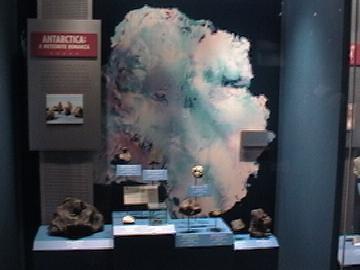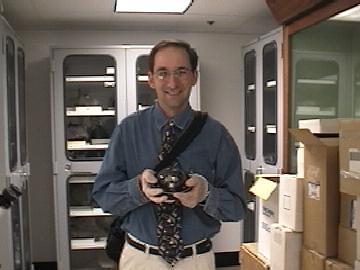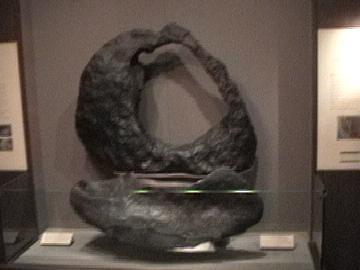16 October, 2002
Research Visit
Although this is not a normal part of the TEA experience, I'm not sure what
would define a "normal" part. Right now, I'm experiencing a "round the horn"
trip around the country visiting members of my research team and learning
what kind of research they do. The first part of the trip brought me to
Washington, D.C., where I visited the meteorite staff and collection at the
National Museum of Natural History. Next, I'll visit with the staff at the
Johnson Space Center in Houston, TX.
I'm actually tracing the path of a meteorite on its journey from Antarctica
to the scientist...only backwards. The Smithsonian is actually one of the
last stops for a meteorite. The meteorite curator, Dr. Tim McCoy, greeted me
first and immediately showed me some of the most spectacular meteorites in
the collection. He quizzed me about my knowledge of meteorites and let me
hold some of his treasures. I actually got to hold a couple of pieces of
Mars. One meteorite, called Nakhla, is famous for not only coming from Mars,
but is also credited with killing a dog in Egypt where it fell in 1911. There
is very little evidence to support this story (unless you're the dog).
The other piece I held doesn't have a name, but rather an alphanumerical
designation, as do all Antarctic meteorites. It's called ALH84001 and was in
the news a few years ago because researchers claimed to have found the fossil
traces of life in it. The process of science is one of continuous change and
chances are that life did not occur in this rock, but it raised some
interesting questions about where and how life began.
When meteorites reach the Smithsonian, they are quickly clipped and ground
into a powder. A technician like Gretchen puts a drop of oil on the grains
and looks at them under a petrographic microscope. When turned at an
orientation that causes the crystals to disappear under cross-polarized
light, Gretchen removes the cross-polars and adjusts the focus to see which
way shadow-like lines (called Beckey lines) move. That tells her what kind
of a meteorite it is. Gretchen has done this so many that she can usually
tell before even applying the oil, but still must be absolutely certain.
The Smithsonian keeps a file of thin sections and all the fragments of the
meteorites they classify. Twice a year, a publication goes out discussing
the characteristics of each of the meteorites examined. Scientists then can
request specific samples on which to conduct their research. The Smithsonian
contains some of the most impressive samples I've ever seen.

Antarctic Meteorite Exhibit at the Smithsonian

Mr. C's joy at holding one of the most famous Martian meteorites from Antarctica.

Classifying Meteorites

This weathered iron meteorite from Tucson is almost as tall as I.

Allende, a large carbonaceous chondrite from Mexico that may hold clues as to where our solar system came from.

Colorado's own Johnstown meteorite.
Contact the TEA in the field at
.
If you cannot connect through your browser, copy the
TEA's e-mail address in the "To:" line of
your favorite e-mail package.
|
